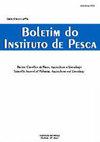FOOD ACCEPTANCE IN DIFFERENT LARVAL STAGES OF Macrobrachium carcinus
IF 0.6
4区 农林科学
Q4 FISHERIES
引用次数: 0
Abstract
Food acceptance in different larval stages of Macrobrachium carcinus was evaluated by investigating the stage at which the ingestion of inert moist diet food begins and by the incidence of Artemia nauplii and inert moist diet in the digestive tract throughout development. Two experiments were carried out: in the first study, the acceptance of the inert diet was evaluated in 60 larvae of each stage (I to XII) fed ad libitum after two hours of fasting. The inert diet was 100% accepted at zoea stage V. In the second study, newly hatched larva was then kept in larval tanks and fed with Artemia nauplii and inert moist diet simultaneously. Fifteen minutes after feeding, 50 specimens of each larval stage were examined and evaluated for the ingestion of these foods. Larvae at stage I did not feed, while larvae at stage II consumed both live and inert food. From the stage of zoea IX, the exclusive consumption of Artemia nauplii was not verified. These data indicate that feeding M. carcinus in larviculture can be initiated at stage II with inert moist diet and Artemia nauplii, and an exclusive supply of inert moist diet from stage IX can be recommended.癌沼虾不同幼虫期对食物的接受
通过研究致癌沼虾不同幼虫阶段开始摄入惰性湿润饲料的阶段,以及在整个发育过程中消化道中无叶蒿和惰性湿润饲料的发生率,对其食物接受度进行了评估。试验分为两个阶段:第一阶段,每一期(1 ~ 12期)60只幼虫,禁食2 h后自由饲喂,评估其对惰性日粮的接受程度。第二项试验将新孵化的幼虫放入幼虫池中,同时饲喂无叶蒿和惰性湿润饲料。喂食15分钟后,对每个幼虫阶段的50个标本进行检查并评估这些食物的摄入情况。I期幼虫不取食,II期幼虫既食用活食,也食用惰性食物。从zoea IX阶段开始,没有证实青蒿的独家消费。这些数据表明,在II期就可以开始用惰性湿润饲料和无叶蒿(Artemia nauplii)饲喂癌芽孢杆菌,并且可以推荐从IX期开始只饲喂惰性湿润饲料。
本文章由计算机程序翻译,如有差异,请以英文原文为准。
求助全文
约1分钟内获得全文
求助全文
来源期刊

Boletim do Instituto de Pesca
FISHERIES-ZOOLOGY
CiteScore
0.80
自引率
0.00%
发文量
24
审稿时长
>12 weeks
期刊介绍:
To publish original articles of research and short communications in the following áreas: Fisheries, Aquaculture, Zootechnology, Limnology, Oceanography, Biology and Pathology of aquatic organisms. The publication depends on the approval of the Editorial Board, based on the peer review.
 求助内容:
求助内容: 应助结果提醒方式:
应助结果提醒方式:


